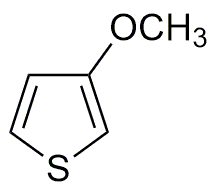3-Methoxythiophene is widely utilized in research focused on:
- Organic Electronics: This compound is a key building block in the development of organic semiconductors, which are used in flexible displays and solar cells, providing lightweight and cost-effective alternatives to traditional materials.
- Conductive Polymers: It serves as a precursor for synthesizing conductive polymers, enhancing the performance of electronic devices, such as sensors and transistors, by improving conductivity and stability.
- Pharmaceuticals: In medicinal chemistry, it is explored for its potential in developing new drugs, particularly for conditions related to inflammation and cancer, due to its unique chemical properties that facilitate biological activity.
- Material Science: The compound is used in creating advanced materials with tailored properties, such as improved thermal stability and mechanical strength, making it valuable in industries like aerospace and automotive.
- Research in Catalysis: It is investigated for its role in catalytic processes, aiding in the development of more efficient chemical reactions that can reduce waste and energy consumption in industrial applications.
General Information
Properties
Safety and Regulations
Applications
3-Methoxythiophene is widely utilized in research focused on:
- Organic Electronics: This compound is a key building block in the development of organic semiconductors, which are used in flexible displays and solar cells, providing lightweight and cost-effective alternatives to traditional materials.
- Conductive Polymers: It serves as a precursor for synthesizing conductive polymers, enhancing the performance of electronic devices, such as sensors and transistors, by improving conductivity and stability.
- Pharmaceuticals: In medicinal chemistry, it is explored for its potential in developing new drugs, particularly for conditions related to inflammation and cancer, due to its unique chemical properties that facilitate biological activity.
- Material Science: The compound is used in creating advanced materials with tailored properties, such as improved thermal stability and mechanical strength, making it valuable in industries like aerospace and automotive.
- Research in Catalysis: It is investigated for its role in catalytic processes, aiding in the development of more efficient chemical reactions that can reduce waste and energy consumption in industrial applications.
Documents
Safety Data Sheets (SDS)
The SDS provides comprehensive safety information on handling, storage, and disposal of the product.
Product Specification (PS)
The PS provides a comprehensive breakdown of the product’s properties, including chemical composition, physical state, purity, and storage requirements. It also details acceptable quality ranges and the product's intended applications.
Certificates of Analysis (COA)
Search for Certificates of Analysis (COA) by entering the products Lot Number. Lot and Batch Numbers can be found on a product’s label following the words ‘Lot’ or ‘Batch’.
*Catalog Number
*Lot Number
Certificates Of Origin (COO)
This COO confirms the country where the product was manufactured, and also details the materials and components used in it and whether it is derived from natural, synthetic, or other specific sources. This certificate may be required for customs, trade, and regulatory compliance.
*Catalog Number
*Lot Number
Safety Data Sheets (SDS)
The SDS provides comprehensive safety information on handling, storage, and disposal of the product.
DownloadProduct Specification (PS)
The PS provides a comprehensive breakdown of the product’s properties, including chemical composition, physical state, purity, and storage requirements. It also details acceptable quality ranges and the product's intended applications.
DownloadCertificates of Analysis (COA)
Search for Certificates of Analysis (COA) by entering the products Lot Number. Lot and Batch Numbers can be found on a product’s label following the words ‘Lot’ or ‘Batch’.
*Catalog Number
*Lot Number
Certificates Of Origin (COO)
This COO confirms the country where the product was manufactured, and also details the materials and components used in it and whether it is derived from natural, synthetic, or other specific sources. This certificate may be required for customs, trade, and regulatory compliance.


